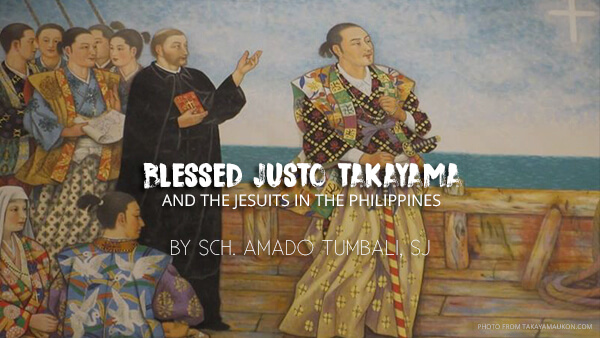


Sch. Amado T. Tumbali, SJ
Asst. Archivist, Philippine Province
The beatification of Justo Takayama Ukon on 7 February 2017 in Osaka, Japan necessitates a special remembrance of Takayama’s special bond with the Jesuits in the Philippines. In 1614, when news of persecution launched by Shogun Tokugawa Ieyasu in Japan had reached Manila, Fr. Valerio de Ledesma, provincial of the Philippines, offered refuge for the Jesuits in Japan. The Provincial also went around raising the interest of Manila citizens in order to stir up compassion toward the persecuted Church. By December, a group of Japanese Catholics, including 15 catechists, and a community of beatas of around 14 to 16 sisters of the Religious of Meako with their mother superior, Julia Naito, and the households of Lord Justo Takayama of Sawa Castle and Lord Joan Naito of Yagi Castle (brother of the mother superior), arrived in Manila and was welcomed with veneration being part of the larger heroic Church in Japan.[1]
The reception given them was what one would expect from a city like Manila. When they arrived at the shore they were saluted by artillery from the fort and the nearby ramparts; nobility, citizens and religious accompanying them to the royal quarters where the Audiencia with its President, the Governor and Captain-General [Juan de Silva], awaited there. From there they went to the Cathedral where a solemn Te Deum was sung and from there to the houses and lodgings prepared for them.[2]
With them too were 22 Jesuits. They were then absorbed by the Philippine Province and distributed between College of Manila and San Miguel residence[3] along the banks of Pasig. The exiled lay were assigned by the Spanish crown to the Jesuit parish of San Miguel.[4]
Takayama and Naito belonged to the nobility. Their being Catholics afforded them removal from their noble ranks and positions as daimyos, giving up of their castles and kingdoms during the shogunate of Toyotomi Hideyoshi, and eventually their expulsion from Japan by Tokugawa Ieyasu.[5] During the reading of the life of Justo Takayama in the beatification ceremony, it was mentioned that Tokugawa intended to avoid the possibility of martyrdom for the Christian samurais and thus sent them into exile.[6] Two months after arriving in Manila, on 5 February 1615, Takayama died of a “tropical illness.” He was given a state funeral by Governor de Silva and was buried at the altar area along with former superiors in the Jesuit church of Sta. Ana in Intramuros,[7] the first stone church of the Jesuits in the Philippines, designed and patterned by Fr. Antonio Sedeño after Il Gesu in Rome.[8]
Four centuries after, an attempt to search for Takayama’s bones have been made. Due to the destruction of Sta. Ana church caused by earthquakes in the early 17th century, the eventual construction of a new church under the patronage of San Ignacio, and, ultimately, the expulsion of the Jesuits from all the Spanish dominions, including the Philippines in 1768, it became an elusive task to find it. However, in 2012, an effort was made to search for Takayama’s bones in the Jesuit cemetery in Sacred Heart Novitiate by a group of Japanese representing the Catholic Bishops Conference of Japan led by Bishop Paul Yoshinao Otsuka of Kyoto, along with Bishop Francis Xavier Osamu Mizobe, SDB, Fr. Renzo de Luca, S.J. and Fr. Albert Fuyuki Hirabayashi, S.J, for a possibility that the human remains, including Takayama’s, from Sta. Ana church were re-interred in the first San Ignacio church of the pre-suppression period, and then to the second San Ignacio church, before all of its bones were finally transferred to Sacred Heart Novitiate cemetery. Despite all these labors, Blessed Justo Takayama’s remains are yet to be found.
______________
[1] Horacio de la Costa, S.J., The Jesuits in the Philippines 1581-1768 (Cambridge: Harvard University Press, 1967), 363; Miguel Saderra Maso, S.J., Philippine Jesuits 1581-1768 & 1859-1924 (Manila: privately printed, 1924), 12.
[2] Saderra Maso, 12.
[3] De la Costa, 363; Fr. Jose Arcilla, S.J. estimates “about 40 Japanese Catholics arrived in Manila towards the end of Dec. 1614.” Jose Arcilla, S.J., “Province Archives,” Philippine Clipper (April 1998): 11. There were 7 European and 15 Japanese Jesuits. However, a European member died during the voyage.
[4] Rene Javellana, S.J., Wood and Stone (Quezon City: Ateneo de Manila University Press, 1991), 198.
[5] Arcilla, 11.
[6] “Beatification of Takayama Ukon,” [on-line]; available from https://www.youtube.com/watch?v=d96PSEkMqHo; accessed 11 February 2017.
[7] Ernie de Pedro, “The Search for the Bones of Takayama,” [on-line]; available from https://takayamaukon.com/the-search-for-the-bones-of-takayama-ukon/; accessed 11 February 2017.
[8] Javellana, 193.